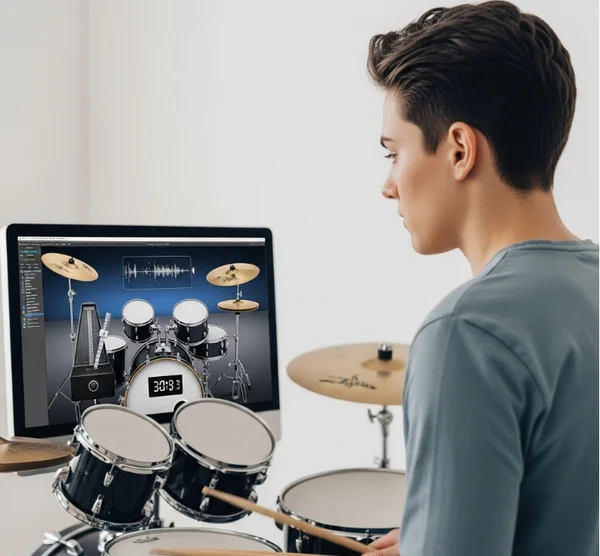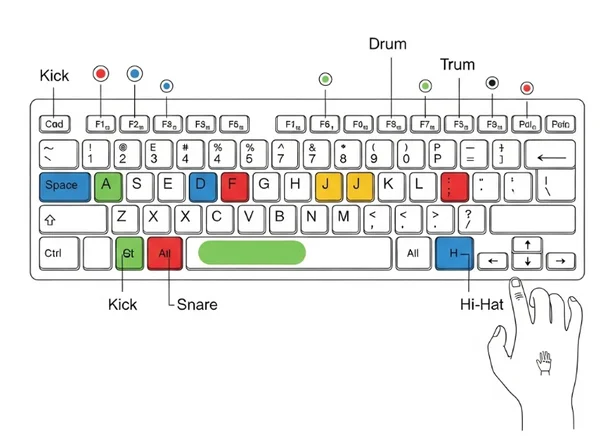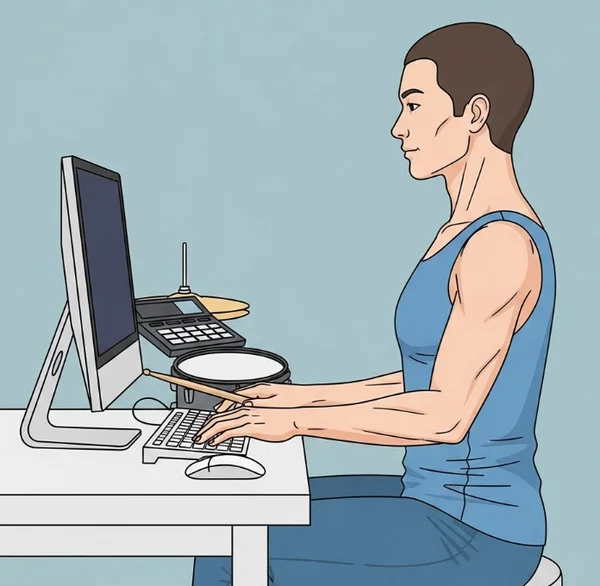Fix Common Beginner Drummer Mistakes on Virtual Drums Now
So, you've started your exciting journey to learn drums online using virtual drums! That's fantastic! But perhaps you're finding that your progress isn't as smooth as you'd hoped, or you're wondering, "Why is my drumming bad?" Don't worry, every drummer, especially when starting out, encounters a few bumps. Identifying and correcting common beginner drummer mistakes early on can significantly accelerate your learning curve and make your online drum practice much more effective and enjoyable. Ready to refine your skills? Try these tips on our virtual drums platform.
This guide will highlight five frequent pitfalls for new drummers using virtual drums and provide actionable virtual drums tips to help you fix them, paving the way for more confident and rhythmic playing.
Mistake #1: Inconsistent Rhythm and Timing - The Foundation Flaw
One of the most critical beginner drummer mistakes is struggling with steady time. How can you improve your timing when you practice drums?

Why Steady Timing is Crucial for All Drummers
Good timing is the backbone of all music. Without it, even the most complex fills or grooves will sound messy. For virtual drumming, where you might be using a keyboard or mouse, developing a solid internal clock is just as important as on an acoustic kit.
The Metronome: Your Best Friend in Online Drum Practice
The metronome is an indispensable tool. Many wonder how to improve virtual drum practice, and the answer often starts here. Using a metronome helps you internalize a steady pulse. If your chosen online drums platform, like the one we offer here, has a built-in metronome, use it! If not, many free metronome apps and websites are available. Start slow and focus on aligning each hit perfectly with the click.
Simple Exercises to Improve Your Internal Clock on Virtual Drums
- Play simple, single-stroke patterns on one drum sound (e.g., the snare on your virtual drum set) along with the metronome.
- Gradually increase the tempo only when you can play consistently at a slower speed.
- Try tapping your foot to the beat as you play; this physical connection can aid timing.
Mistake #2: Random or Inefficient Sticking/Finger Patterns - The Coordination Challenge
Another common issue, especially when adapting to keyboard or touch-based virtual drums, involves awkward or inconsistent "sticking" (or finger/mouse click patterns). This is a frequent online drum practice error.

Understanding Basic Sticking for Keyboard/Mouse/Touch Drumming
While you're not holding physical sticks, the concept of alternating hands (or fingers/clicks) in an efficient way still applies. For instance, if playing a series of snare hits on your online drum kit, try alternating between two designated fingers or ensuring your mouse clicks are evenly spaced and controlled. What are some effective drumming technique approaches for this?
Developing Smooth Transitions Between Drum Sounds
Beginners often struggle with moving smoothly between different parts of the virtual drum (e.g., from hi-hat to snare to kick). Plan your "movements" – which finger or click pattern will you use for each sound to make transitions fluid? Practicing these transitions slowly on our user-friendly virtual drums will build muscle memory.
Practice Drills for Better Hand (or Finger) Coordination
- Create simple patterns that involve two or three drum sounds and repeat them.
- Focus on evenness and clarity rather than speed initially.
- Imagine you are using sticks; this mental model can sometimes help with coordination even on a keyboard.
Mistake #3: Neglecting the Basics - Rushing into Complexity
It's tempting to want to play complex beats and fills right away when you learn drums online, but skipping fundamentals is a major beginner drummer mistake.
The Importance of Mastering Simple Beats First
Solid, simple grooves are the foundation of most songs. Before attempting intricate patterns, ensure you can play basic rock, pop, or funk beats with consistent timing and feel on your virtual drums. These are essential virtual drums tips for long-term growth.
Why Rudiments (Even Simplified for Virtual Drums) Matter
Drum rudiments (like single strokes, double strokes, paradiddles) are the building blocks of drumming. Even if you're playing on a keyboard, understanding and practicing simplified versions of these can vastly improve your control, speed, and creativity. Can you adapt rudiments effectively for online drum practice? Yes!
Focusing on Groove and Feel Over Flashy Fills Initially
A drummer's primary role is to provide a solid rhythmic foundation – the groove. While fills are fun, prioritize developing a good, steady feel. A simple beat played with great feel is far more effective than a sloppy, complex fill.
Mistake #4: Poor Posture and Ergonomics - The Physical Strain
Often overlooked in online drum practice, especially with virtual drums, is the importance of good posture and ergonomics.

How Bad Habits Can Hinder Your Virtual Drumming
Slouching or having an awkward keyboard/mouse setup can lead to physical discomfort, fatigue, and even repetitive strain injuries over time. This can make your practice drums sessions shorter and less effective.
Tips for a Comfortable and Efficient Setup for Online Drums
- Sit upright with your shoulders relaxed.
- Ensure your keyboard/mouse is at a comfortable height, allowing your wrists to be relatively straight.
- Take regular breaks during longer virtual drumming sessions on platforms like our accessible online drums.
Avoiding Tension for Longer, More Productive Practice Sessions
Be mindful of tension in your hands, wrists, arms, and shoulders. Try to stay relaxed. If you feel tension building, take a break and stretch. This is key to avoiding online drum practice errors related to physical strain.
Mistake #5: Not Listening Critically to Your Own Playing - The Awareness Gap
One of the most subtle but impactful beginner drummer mistakes is not actively or critically listening to what you're actually playing.

The Value of Recording and Reviewing Your Virtual Drum Sessions
If your virtual drums platform allows for recording (or if you can use external software), do it! Listening back to your playing can reveal inconsistencies or errors you might not notice while actively drumming. This is a powerful way to improve drumming.
Actively Listening for Inconsistencies and Areas for Improvement
When you practice or listen back, ask yourself: Is my timing steady? Are all the hits clear? Are my transitions smooth? Are there any common drum errors I'm making repeatedly?
Learning to Be Your Own Best Critic (Constructively!)
Develop the ability to assess your playing objectively. Don't be overly harsh, but be honest about areas that need work. This self-awareness is crucial for anyone looking to truly learn drums online.
Turn Mistakes into Stepping Stones for Virtual Drumming Success
Making mistakes is a natural and essential part of learning any new skill, including playing virtual drums. The key is to recognize these common beginner drummer mistakes, understand why they happen, and actively work to correct them. By applying these virtual drums tips and maintaining consistent online drum practice, you'll see significant improvement.
Don't let these potential pitfalls discourage you. Embrace the challenge, be patient with yourself, and remember that every practice session on our engaging virtual drums platform is a step forward. Which of these mistakes have you encountered? Share your experiences or ask for more specific advice in the comments below!
Your Questions on Avoiding Beginner Drummer Mistakes Answered
Why is my timing so inconsistent when I play virtual drums?
This is a very common beginner drummer mistake. It often stems from not practicing with a metronome consistently or trying to play too fast too soon. Focus on slow, deliberate practice with a metronome using a reliable online drums tool like ours right here.
How can I improve my coordination for keyboard drumming?
Start with simple, two-limb (or two-finger) patterns on your virtual drum set. Gradually add more "limbs" as you get comfortable. Slow, repetitive practice of specific movements is key to building coordination for any drumming technique.
Is it bad to only practice on virtual drums and not a real kit?
Not at all, especially for beginners! Virtual drums are excellent for developing rhythm, basic coordination, and understanding song structures. Many skills learned during online drum practice are transferable. Our virtual drums are a great starting point.
What's the most important thing to focus on as a beginner virtual drummer?
Solid timing and a good feel for simple grooves. These are the foundations. Master these before worrying too much about speed or complex fills. This is a core piece of virtual drums tips for all new players.
How do I know if I'm making progress or just repeating mistakes?
Try to record yourself if possible and listen back critically. Also, focus on one specific beginner drummer mistake or technique for a week, then assess if you've improved in that area. Patience and mindful online drum practice are essential to improve drumming.